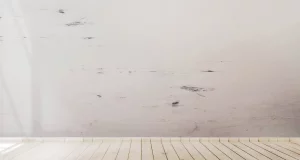
No one really witnesses the birth of scuff marks, yet they exist. Every time you sit on the sofa, drag a chair, or wear shoes around the house, microscopic (or not so much) scuffs and marks are left on your painted walls or on your floors.
Lucky for you, scuff marks are easily removed using common household products. If you manage to get to them while they are fresh, the removal will be extra quick and easy so watch out.
We will show you how to get rid of all scuff marks using simple ingredients like baking soda and dish soap. Keep reading and try it out for yourself. Your walls and floors will be spotless.
Getting rid of scuffs and marks on walls
There are different types of walls. Your walls can be tiled, painted, or wallpapered. Keep in mind that the tips we mention below are most suitable for painted walls. If you have unpainted or wooden walls, skip these steps and check out the tips we have for flooring.
- Wipe it with a damp cloth – Many scuff marks can be removed by simply rubbing a damp microfiber cloth over them. This works especially well if the mark is fresh so give it a try just in case – you may save yourself time and effort. Once you wipe the area with a slightly damp cloth, buff it with a dry soft one to restore the finish.
- Mix a cleaning solution – If the mark remains, it is time to mix a solution of ½ teaspoon of dishwashing liquid and 2 cups of water. Use the same cloth dipped in the cleaning solution and gently scrub the mark. If the scuff is a deep one, dip the edge of the cloth in dry baking soda and begin scrubbing it gently. Once it is completely gone, rinse the area with a cloth dipped in plain water, then buff it with a dry microfiber cloth.
- Use a melamine sponge – The final option is to use a melamine cleaning sponge. Dampen it and squeeze the water out. Gently scrub the mark with even pressure. Don’t be too harsh or you may lose some paint. Finish by wiping the area down with a damp cloth.
- For wallpapered walls – Most wallpaper does not hold up well to water cleaning, and a heavy hand with the melamine sponge will result in holes or loss of colour. Scuff marks can be removed with an art gum eraser instead. Try the liquid detergent and water mixture for walls for really tough marks, but test it first in an inconspicuous area to ensure it doesn’t harm or watermark the paper.
Removing scuffs and marks from floors
Scuff marks can be quite obvious, especially if your floors are light-coloured. Unfortunately, flooring materials are not simple to replace. Follow the instructions below and find out how to get rid of marks. To prevent them from happening, avoid wearing shoes inside and dragging furniture across the room.
- Use an old tennis ball – Grab a tennis ball if you notice a black scuff mark on your wood floors (a used one is just fine). Cut an X in the ball with a sharp knife, then slip the ball onto the end of a broom or mop handle. Apply gentle pressure to the scuff mark with the ball to buff away the mark.
- Use an eraser – The marks on the wood can be removed with art gum or a school pencil eraser. Just make sure the eraser’s surface is clean. Scuff the scuff mark, then vacuum any shavings from the floor.
- Scrub with a microfiber cloth – For fresh stains, you can use a microfiber cloth. They are made of many small plastic fibres that will gently scrub away the scuff mark. If that does not work so well, dampen the microfiber cloth with plain water and try again.
- Baking soda – The tennis ball, eraser, and microfiber cloth can also be used on ceramic, stone, and laminate floors. However, because these materials are more durable than some wood finishes, you can use baking soda to gently scrub away tough scuff marks. Simply wet a cotton or microfiber cloth and sprinkle baking soda on the scuff. Scrub any residue away with the cloth. Finish by wiping down the area with a clean, damp cloth.
- WD-40 for vinyl floors – If you’ve tried everything else to remove dark scuff marks from vinyl floors and nothing has worked, try some WD-40. Make sure you test this powerful solvent in a hidden location to ensure that it does not discolour your vinyl. When you’re confident that it’s safe, spritz it on the scuff mark and wait five minutes. Wipe with a soft cloth to clean. You may need to use a good cleaner in the area to restore the shine of your vinyl.